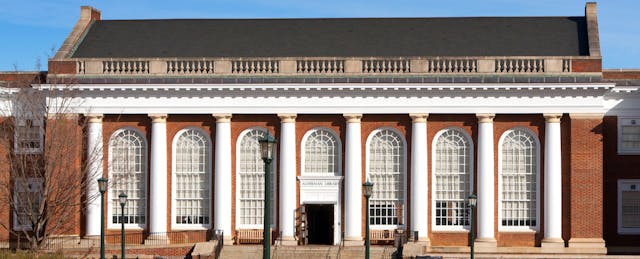An art historian and a 3D printer, a German linguist and open-source Arduino, an archeologist and a laser scanner: welcome to a typical day in the makerspace at the University of Virginia’s Scholars’ Lab (SLab). The SLab is an experimental humanities research and training center sitting in a sunny corner of Alderman Library, a brief walk from Edgar Allen Poe’s college dorm. The lab’s common room has checkerboard floor tiles, a slew of seating, and a series of whiteboards, covered in notes. This is no damp study with dusty quills, but a workshop abuzz with students modeling, testing and making.
In a corner of the common room is the makerspace, holding a collection of scanners, 3D printers, and wearable technologies. It’s open from 1-5 p.m. on weekdays, with American History and English PhDs available to answer questions about tools like the 3D printer—or how to challenge the ethical assumptions of a website.
Makerspaces in general aren’t particularly made for literary scholars or art history PhDs. They’re traditionally community-funded workshops with low-fi manufacturing tools for sharing supplies individuals couldn’t afford on their own. And they tend to have a tinkering ethos, as a place to be playful with printers or code custom robots. They’re for inventors, not scholars stuck in ivory towers.
Critical Making
The folks at the SLab disagree and are working to change the conversation. Purdom Lindblad, a bubbly technologist who runs the SLab’s graduate programs, tells EdSurge, “The technology is relatively easy. What’s really hard is to understand what that technology is doing to the questions that you’re asking and how it’s framing the results on the other side.”
The SLab makerspace is different from most because it injects the use of technologies with the political, philosophical, intercultural, historical, and religious questions of the humanities. Students are encouraged to oscillate between creation and criticism.
Pedagogy and Projects
Many professors bring their classes to the space. There’s an archeology course that scanned artifacts, then printed them for a museum exhibit. There’s a Slavic languages course that printed Russian icons for display as a way to explore Russian identity. In the works is a 200-level German course that will play with code, printers and Arduino—entirely in German.
According to Jennifer Grayburn, a makerspace technologist who just finished her PhD in art history, the courses have been very successful. Many of the faculty plan to come back in the future, she says. “Professors are getting students to creatively engage with the technology, approaching the content in a new way, rather than just testing, quizzing, memorizing and essay writing.”
When undergraduate archeology students scanned Greek vases for the Fralin Museum, the hands-on work turned into a discussion about the implications of scanning technologies in the field. What does it mean to leave the material artifact behind and scan merely a 3D image? While the students consider these questions, they’re also learning how to use tools applicable to future careers. Grayburn cites a phrase popular with another staff member, “What I cannot create, I do not understand.” And what I can make might just get me hired.
Grayburn, recent PhD that she is, speaks of the academic job market and its emphasis either on digital teaching or research with a digital component. “There is an increasing need for students to be versed in the language and the vocabulary and the methods just so they can understand what is happening with technology.” Hires with backgrounds in the humanities need digital expertise, an understanding of the way digital technology influences the questions they can ask.
The Shift in the Humanities
It must finally be noted that a space like this is hardly uncontroversial. The SLab is a leader in the Digital Humanities (DH), an ever undefinable term attempting to encompass the clashes and collaborations between computers and humanists. A recent series of articles in the L.A. Review of Books spotlights the DH drama: Is it part of “the neoliberal takeover of the university”? Or is it simply the “form taken in the digital age by scientific, explanatory, empirical, rationalistic … approaches to the history of literature and culture”?
Those in the SLab makerspace embrace these debates, but also look forward. As George Mason PhD student and SLab technologist Ammon Shepherd tells EdSurge, “The people here are trying to figure out how to incorporate these new technologies into humanities research, to explore how it’s all going to evolve.” And they're asking questions. Can the SLab use the makerspace to design products with students and scholars in mind? How does grant funding change for humanities research?
But all this radical talk comes after an explicit prioritization of teaching and learning. The SLab wants students to play and tinker, to learn through curiosity, and to critically examine the modern world. Maybe they’ll find something relevant to their course or research—maybe they won’t. But in the process of making, they’ll find new reasons to love (or hate) the humanities.


